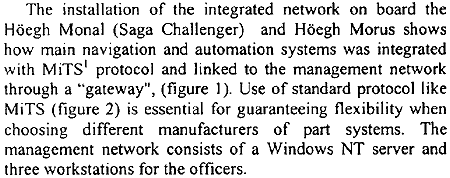
The following list represents the primary applications that are available on the integrated management solution:
・ Reporting System - includes automatically recorded data, like ships position, engine performance, cargo condition and manual input from the officers, i.e. deck log, port log, machinery log. The important factor in this case is the effectiveness in reducing work load for entering of input data. Today's paperbased reporting systems force users to write the same information several times in different forms. It is projected that much of this paper work will be reduced through computer application. Another advantage is that the data exchange between ship and shore does not require high speed datalinks and can be updated regularly, one or two times a day. The database structure from this project is basis for the proposed AP 2342 standard.
・ Weather Routing - provides the officers on board access to weather charts. These weather prognoses, received from Meteorological Institutes, are used as a decision tool for selecting the best route to the next port. This requires a high speed data communication shore to ship and the datafiles can be in the order of 0.75-1.0 MB. The cost of these transmissions is likely to be reduced in the years to come.
・ Load calculator - this installation is linked to the management network and will read data from the "Gateway process". Stability, forces and stresses, etc for the ship can be continuously calculated.
・ High Speed Data Communication with Inmarsat B, 64 kbit/s, - gives better performance for transferring datafiles than the standard A system with 9.6 kbit/s. For ships sailing in coastal waters, a possibility for switching between GSM and Inmarsat will be a cost-efficient solution.
・ Maintenance Management System - connected to the management network and uses "condition monitoring data" to trigger maintenance tasks. This has usually been "counting of running-hours from rotating machinery", but in this case both the technical conditions from the main engine and faults from the fire alarm systems are used to trigger the maintenance and inspection tasks.
・ Interactive Electronic Manuals (from several companies integrated in a structured database) - provide quick access to relevant information related to the actual task. This can be a maintenance task, trouble shooting or requirement for spare parts for overhaul.
・ Computer Based Training Modules - cover familiarization training, training on technical systems, basic training, etc.
・ Condition Monitoring of Main Engine - includes the system on board, but also transfer of information to the shipowners office, for simplification of trouble shooting by providing the chief engineer and the inspector with the same information at the same time. (Figure 3)
Operational experience
The MiTS technology has been proven to be stable and reliable. The logging application on the MiTS Net has been working without problems after the installation problems were solved. The clients on the ship management net picks up their data from the logging processes. From the office, new logging processes can be configured in addition to the predefined clients running continuously, and the raw data from such processes can be transferred to the office.
The onboard systems which have been commissioned have the functionality which was planned when the test phase of the project started. As can be expected from systems coming straight out of the development labs, we have experienced that the testing quality of the products has not been perfect. The consequence of this has been the occurrence of occasional error conditions during operation.
Data communication between ship and shore
Functionally, data flows correctly between ship and shore, i.e. data are correctly transferred and received by the system ashore. With regard to the transmission technology, we have under test conditions conducted file transfers with transmission speeds up to 7000 characters per second simultaneously both ways, This is a good result on a 64 kB satellite link.
The stability of the high speed data transmission has, however, been lower than anticipated.
The Pilot Ships have Filipino crew in all positions. The senior officers, as well as 2nd engineer and electrician, has received a dedicated training programme for the Pilot Ship systems, lasting about 2 weeks.
Our experience was that it is very important that they as soon as possible after the course period gets onboard to have practical training in using the systems. The training must be followed up in the first period to see to that starting problems are solved, and that skills and procedures are well drilled. The follow up has been done through review of the data received from the ships, and when procedures have not been correctly performed, information is sent to the ship with further explanation. The ships have also been visited by project personnel for system upgrades and follow up training and problem solving.
1MiTS - Maritime Technology Standard, "open integration network mechanism", IEC TC80/WG6.
2AP234 - ISO TC184/SC4-T23